- 333
- 262
- 63
- Location
- Denver, Colorado
Not long after I got my truck, I decided I'd replace every bit of the age-and-vibration-subjected, crooked, crushed, kinked, dented, copper air and fuel line with DOT (Department of Transportation approved) nylon tubing other than the 2 exceptions listed below*.
THE 2 EXCEPTIONS...
*1. The air compressor discharge line; Because the air coming out of the compressor head can measure in the hundreds of degrees (not condusive to nylon) I used a 2' section of braided stainless discharge hose going from the compressor head down to the frame rail, and a brass elbow to connect the 2' section to a 4' section of stainless discharge going back, along the inside of the frame rail, toward the air wet-tank. I then connected 1/2" DOT nylon between the 4' section and the wet tank. My Thanks to simp5782 for his input on this.
2' section; https://www.amazon.com/gp/product/B078Z1YGV4/ref=ppx_yo_dt_b_asin_title_o03_s00?ie=UTF8&psc=1
4' section; https://www.amazon.com/gp/product/B078Z1T253/ref=ppx_yo_dt_b_asin_title_o00_s00?ie=UTF8&psc=1
*2. The fitting coming out of the block on top of the fuel tank/lift pump. This is a flare fitting, and I could not find a fitting that was the required flare size on the block side, with 1/2" compression on the other end. So, I made a flared 2" copper stub to connect the block to the 1/2" DOT nylon, as outlined in my post here; https://steelsoldiers.com/threads/w...r-deuce-this-week.67703/page-412#post-2169331
The majority, if not all, the rest of the fittings needed were male or female NPT*, compression, or a combination of the two (YMMV). *Tapered pipe thread, also referred to as MIP, FIP, etc.
Other than the compressor discharge line heat, DOT nylon has been proven to handle the compressed air, vacuum, and fuel delivery needs of our trucks, although it does need to be protected with a rubber hose sleeve anywhere it's likely to make contact and rub on a hard edge, i.e. when passing through holes in the frame, or cross-members. But, I found the nylon very easy to work with, and I believe it looks so much better. Another bonus to working with the nylon is that you can do away with the hose between the 1/2" copper primary fuel filter line and the IP booster pump, as well as the hose between the secondary/final fuel filter mount and the fuel tank return line. Those hoses were there to dampen vibration between the engine and the respective copper lines. because the nylon handles vibration much better than copper, no more need for those hoses. Since I have a vented fuel cap, I did away with the fuel tank vent line. Since I have a remote, vented, master cylinder reservoir, I got rid of the MC vent line too. Although I did have to make a trip or two to napa to buy whatever pipe-thread-size x compression-size fittings I might need along the way, I made myself a copper-to-nylon conversion kit, so I'd always have the nylon line, tubing inserts, and compression sleeves all in one box, on hand, and wasn't repeatedly having to order more of that stuff...
The kit;
- 50' 1/2" O.D. DOT approved nylon tubing (ebay)
- 50' 3/8" O.D. " " (This also did all the 3/8" polymer lines between the injection pump and secondary/final filter mount too)
- 25' 1/4" O.D. " " (This also did all the fuel injector return lines, and I used it to replace all remaining 3/16" copper too)
- 24 ea. brass tubing inserts for each of the 3 sizes of tubing (these slip inside the ends of the tubing for reinforcement)
- 24 ea. brass compression rings for each of the 3 sizes of tubing (these slip over the outside of the tubing ends, to provide the seal)
- 2'-3' of rubber hose, to act as protector sleeves, for each of the 3 sizes of tubing, with as close an I.D. as I could get while still being able to slide the hose over the respective tubing (I took a small piece of each size tubing to the store with me so I could test the fit before buying)
- Plastic tubing cutter
- Copper tubing cutter
- 100 ea. 8" cable ties to cinch the rubber hose sleeves to the tubing, and keep things tidy.
- A cheat-sheet listing pipe thread sizes, flare sizes, and compression thread sizes, so I could measure a fitting with calipers while it was still on the truck, and know what size pipe-thread x OD compression fitting to ask for when I got to the store.
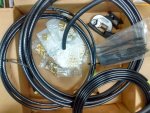
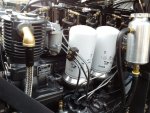
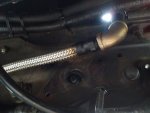
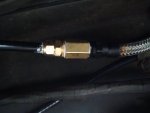
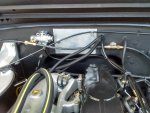
Pics including airpack supply connections
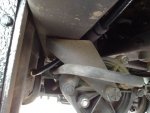
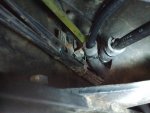
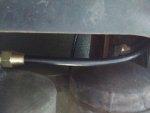
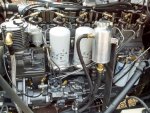
Cheat-sheet
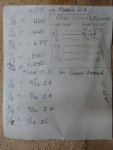
THE 2 EXCEPTIONS...
*1. The air compressor discharge line; Because the air coming out of the compressor head can measure in the hundreds of degrees (not condusive to nylon) I used a 2' section of braided stainless discharge hose going from the compressor head down to the frame rail, and a brass elbow to connect the 2' section to a 4' section of stainless discharge going back, along the inside of the frame rail, toward the air wet-tank. I then connected 1/2" DOT nylon between the 4' section and the wet tank. My Thanks to simp5782 for his input on this.
2' section; https://www.amazon.com/gp/product/B078Z1YGV4/ref=ppx_yo_dt_b_asin_title_o03_s00?ie=UTF8&psc=1
4' section; https://www.amazon.com/gp/product/B078Z1T253/ref=ppx_yo_dt_b_asin_title_o00_s00?ie=UTF8&psc=1
*2. The fitting coming out of the block on top of the fuel tank/lift pump. This is a flare fitting, and I could not find a fitting that was the required flare size on the block side, with 1/2" compression on the other end. So, I made a flared 2" copper stub to connect the block to the 1/2" DOT nylon, as outlined in my post here; https://steelsoldiers.com/threads/w...r-deuce-this-week.67703/page-412#post-2169331
The majority, if not all, the rest of the fittings needed were male or female NPT*, compression, or a combination of the two (YMMV). *Tapered pipe thread, also referred to as MIP, FIP, etc.
Other than the compressor discharge line heat, DOT nylon has been proven to handle the compressed air, vacuum, and fuel delivery needs of our trucks, although it does need to be protected with a rubber hose sleeve anywhere it's likely to make contact and rub on a hard edge, i.e. when passing through holes in the frame, or cross-members. But, I found the nylon very easy to work with, and I believe it looks so much better. Another bonus to working with the nylon is that you can do away with the hose between the 1/2" copper primary fuel filter line and the IP booster pump, as well as the hose between the secondary/final fuel filter mount and the fuel tank return line. Those hoses were there to dampen vibration between the engine and the respective copper lines. because the nylon handles vibration much better than copper, no more need for those hoses. Since I have a vented fuel cap, I did away with the fuel tank vent line. Since I have a remote, vented, master cylinder reservoir, I got rid of the MC vent line too. Although I did have to make a trip or two to napa to buy whatever pipe-thread-size x compression-size fittings I might need along the way, I made myself a copper-to-nylon conversion kit, so I'd always have the nylon line, tubing inserts, and compression sleeves all in one box, on hand, and wasn't repeatedly having to order more of that stuff...
The kit;
- 50' 1/2" O.D. DOT approved nylon tubing (ebay)
- 50' 3/8" O.D. " " (This also did all the 3/8" polymer lines between the injection pump and secondary/final filter mount too)
- 25' 1/4" O.D. " " (This also did all the fuel injector return lines, and I used it to replace all remaining 3/16" copper too)
- 24 ea. brass tubing inserts for each of the 3 sizes of tubing (these slip inside the ends of the tubing for reinforcement)
- 24 ea. brass compression rings for each of the 3 sizes of tubing (these slip over the outside of the tubing ends, to provide the seal)
- 2'-3' of rubber hose, to act as protector sleeves, for each of the 3 sizes of tubing, with as close an I.D. as I could get while still being able to slide the hose over the respective tubing (I took a small piece of each size tubing to the store with me so I could test the fit before buying)
- Plastic tubing cutter
- Copper tubing cutter
- 100 ea. 8" cable ties to cinch the rubber hose sleeves to the tubing, and keep things tidy.
- A cheat-sheet listing pipe thread sizes, flare sizes, and compression thread sizes, so I could measure a fitting with calipers while it was still on the truck, and know what size pipe-thread x OD compression fitting to ask for when I got to the store.





Pics including airpack supply connections




Cheat-sheet

Last edited:


